change time AUDI Q7 2017 Owner´s Manual
[x] Cancel search | Manufacturer: AUDI, Model Year: 2017, Model line: Q7, Model: AUDI Q7 2017Pages: 402, PDF Size: 100.39 MB
Page 331 of 402
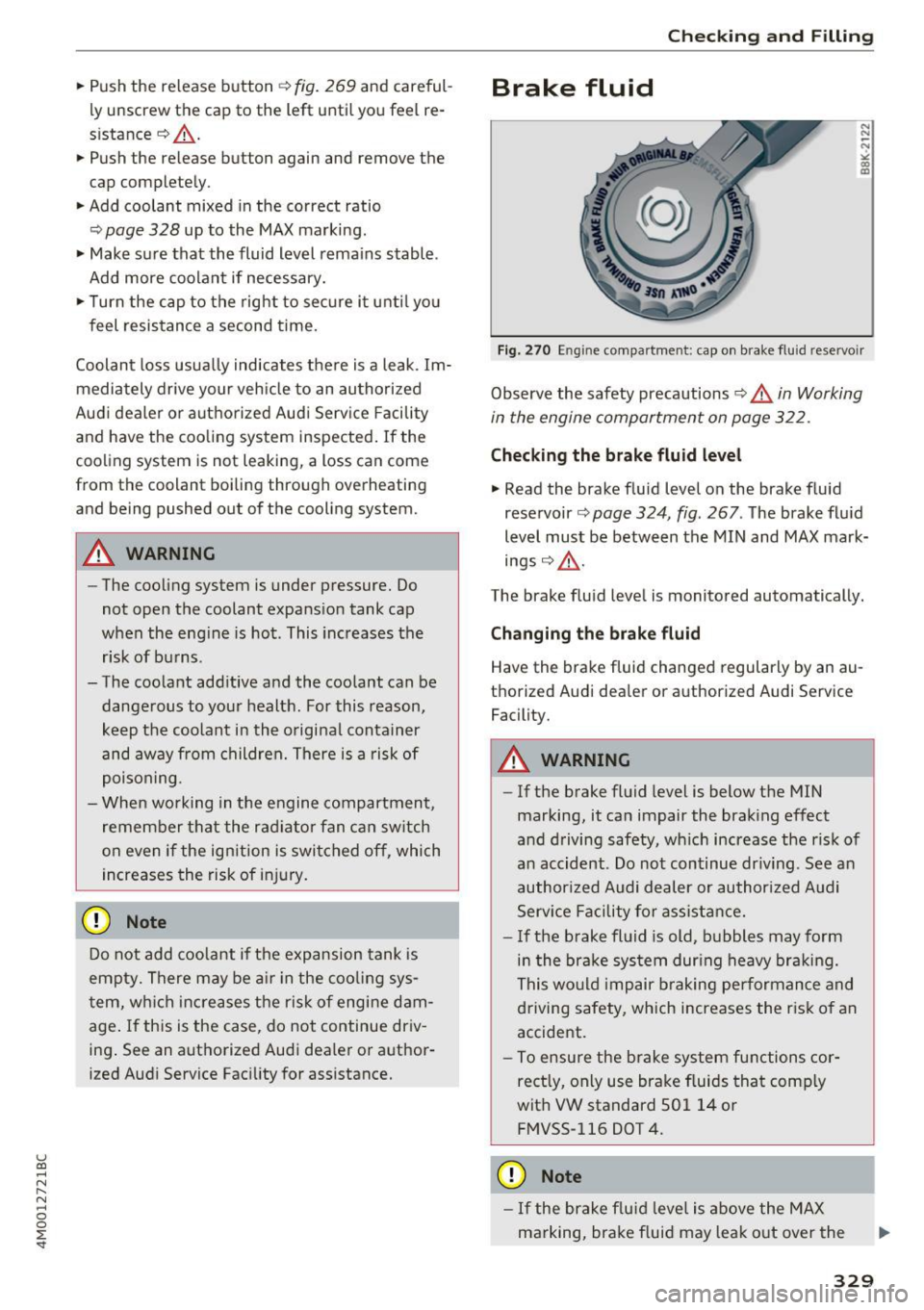
u (0 ...... N r--. N ...... 0
0
:E
ly unscrew the cap to the left until you feel re
sistance ¢,&. .
.. Push the release button again and remove the
cap completely .
.. Add coolant mixed in the correct ratio
¢page 328 up to the MAX marking .
.. Make sure that the fluid level remains stable .
Add more coolant if necessary .
.,. Turn the cap to the right to secure it until yo u
feel resistance a second time.
Coolant loss usually indicates there is a leak . Im
mediately drive your vehicle to an authorized
Audi dealer or authorized Aud i Service Facility
and have the cooling system inspected. If the
cooling system is not leaking, a loss can come
from the coolant boiling through overheating
and being pushed out of the cooling system.
A WARNING
-The cooling system is under pressure. Do
not open the coolant expansion tank cap
when the eng ine is hot. This increases the
risk of burns .
- The coolant additive and the coolant can be
dangerous to your health. For this reason,
keep the coolant in the original container
and away from children. There is a risk of
poisoning.
- When working in the engine compartment,
remember that the radiator fan can switch
on even if the ign ition is switched off, which
increases the risk of injury.
CD Note
Do not add coolant if the expansion tank is
empty. There may be air in the cooling sys
tem, which increases the risk of engine dam
age . If this is the case, do not continue driv
ing . See an authorized Audi dealer or author
ized Audi Service Facility for assistance.
Checking and Filling
Brake fluid
Fig. 270 Engine compartment: cap on brake fluid reservo ir
Observe the safety precautions¢ A in Working
in the engine compartment on page 322 .
Checking the brake fluid level
.. Read the brake fluid level on the brake fluid
reservoir ¢
page 324, fig . 267. The brake fluid
level must be between the MIN and MAX mark
ings ¢,& .
The brake fluid level is monitored automatically.
Changing the brake fluid
Have the brake fluid changed regularly by an au
thorized Audi dealer or authorized Audi Service Facility.
A WARNING
- If the brake flu id level is below the MIN
marking, it can impair the braking effect
and driving safety, wh ich increase the risk of
an accident. Do not continue dr iving. See an
authorized Audi dealer or authorized Audi
Serv ice Facility for assistance.
- If the brake fluid is old, bubbles may form
in the brake system dur ing heavy braking.
This would impair braking performance and
driving safety, which increases the risk of an
accident.
- To ensure the brake system functions cor
rectly, only use brake fluids that comp ly
with VW standard 501 14 or FMVSS-116 DOT 4.
CD Note
-If the brake flu id l eve l is above the MAX
marking, brake fluid may leak out over the
329
Page 334 of 402
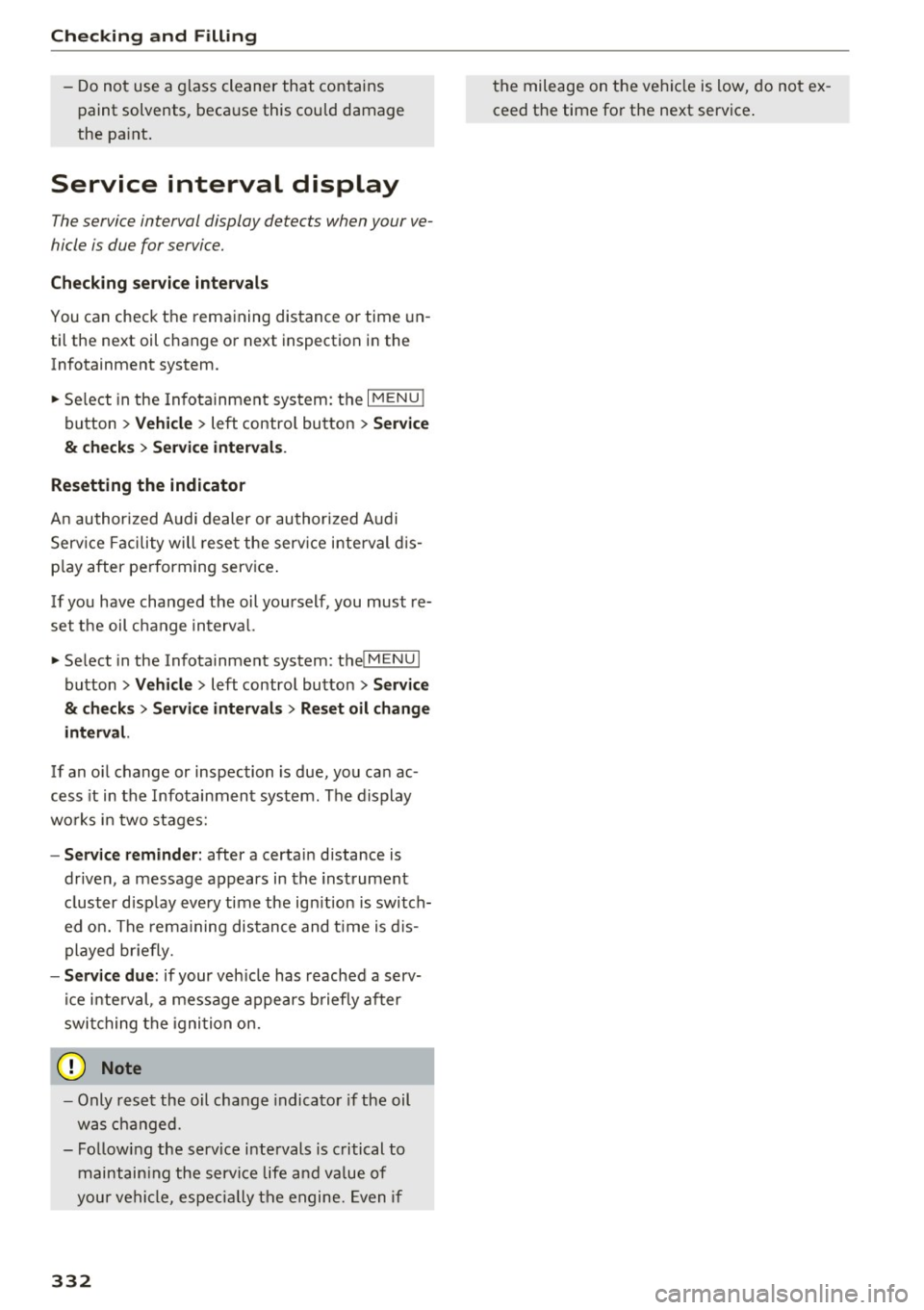
Check ing and F illing
- Do not use a glass cleaner that contains
paint solvents, because this could damage
the pa int .
Service interval display
The service interval display detects when your ve
hicle is due for service.
Checking service int ervals
You can check the remaining distance or time un
til the next oil change or next inspection in the
Infotainment system .
.. Se lect in the Infotainment system: the
I MENU I
button
> Vehicle > left contro l button > Ser vice
& check s > Ser vice inte rval s.
Resetting the indicator
An author ized Audi dealer or author ized A udi
Serv ice Facility will rese t the serv ice interval d is
p lay after performing serv ice .
I f you have changed the oil yourself, you must re
set the oil change interva l.
.. Select in the Infotainment system: the!MENUI
button
> Vehicle > left contro l button > Service
& chec ks > Service interval s > Reset oil change
interval.
If an oil change or inspection is due, you can ac
cess it in the Infotainment system. The display
wo rks in two stages:
- Servic e reminde r: after a certain distance is
driven, a message appears in the inst rument
cluster d isp lay every time the ign ition is switch
ed on. The rema ining distance and t ime is d is
played br iefly.
- Service due : if your vehicle has reached a serv
ice i nterval, a message appears briefly after
swi tching the igni tion on.
(D Note
- Only reset the oil change indicato r if the oil
was changed.
- Fo llow ing the service i ntervals is c ritical to
maintain ing the service life a nd va lue of
you r vehicle, especia lly the engine. Even if
332
the mileage on the vehicle is low, do not ex
ceed the time for the next service .
Page 340 of 402

Wheels
"XL" "xl" "EXTRA LOAD" or "RF" I I I
on the sidewall.
Rim
means a metal support for a tire
or a tire and tube assembly upon
which the tire beads are seated.
Rim diameter
means nominal diameter of the
bead seat . If you change your
wheel size, you w ill have to p ur
chase new tires to match the new rim diameter .
Rim size designation
means rim diameter and width.
Rim width
means nomina l distance between
rim flanges.
S idewall
means that portion of a tire be
tween the tread and bead .
Speed rating (letter code)
means the speed at which a tire is
designed to be driven for extend
ed periods of time. The rat ings
range from 93 mph (150 km/h)
to 186 mph (298 km/h)
¢ table
on page 334.
You may not find
this information on all tires be
cause it is not requ ired by law.
33 8
The speed rating letter code,
where applicable, is molded on
the tire sidewall and ind icates the
maximum permissible road
speeds
¢ .&. in Winter tires on
page 348.
Tire pressure monitoring system
means a system that detects
when one or mo re of a vehicle's
tires are underinflated and illum i
na tes a low tire pressure warning
telltale .
Tread
means that portion of a tire that
comes into contact w ith the road .
Tread separation
means pulling away of the tread
from the t ire carcass .
Treadwear indicators (TWI)
means the projections within the
principal grooves designed to give
a vis ua l indication of the deg rees
of wear of the t read. See
¢ page 342, Treadwear indicator
for mo re information on measur-
ing tire wear. .,.
Page 346 of 402
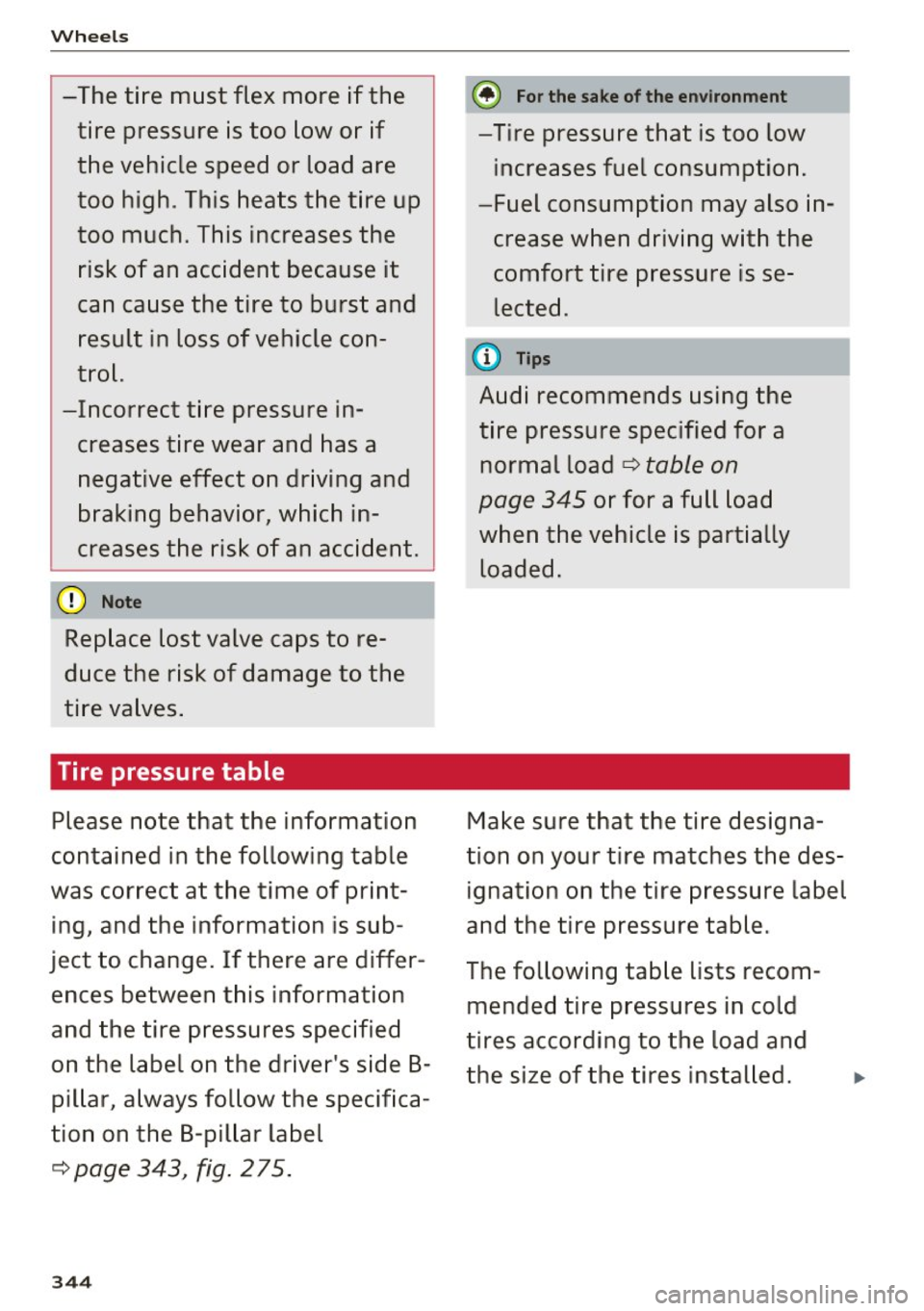
Wheels
-The tire must flex more if the tire pressure is too low or if
the vehicle speed or load are
too high . This heats the tire up
too much. This increases the
risk of an accident because it
can cause the tire to burst and
result in loss of vehicle con
trol.
-Incorrect tire pressure in creases tire wear and has a
negative effect on driving and
braking behavior, which in
creases the risk of an accident.
(D Note
Replace lost valve caps to re
duce the risk of damage to the
tire valves.
Tire pressure table
Please note that the information
contained in the following table
was correct at the time of print
ing, and the information is sub
ject to change. If there are differ
ences between this information
and the tire pressures specified
on the label on the driver's side 8-pillar, always follow the specifica
tion on the 8-pillar label
¢ page 343, fig. 275.
344
(i} For the sake of the environment
-Tire pressure that is too low
increases fuel consumption.
-Fuel consumption may also in
crease when driving with the
comfort tire pressure is se
lected .
(D Tips
Audi recommends using the
tire pressure specified for a
normal load
¢ table on
page 345
or for a full load
when the vehicle is partially loaded.
Make sure that the tire designa
tion on your tire matches the des ignation on the tire pressure label
and the tire pressure table.
The following table lists recom mended tire pressures in cold
tires according to the load and
the size of the tires installed.
Page 353 of 402
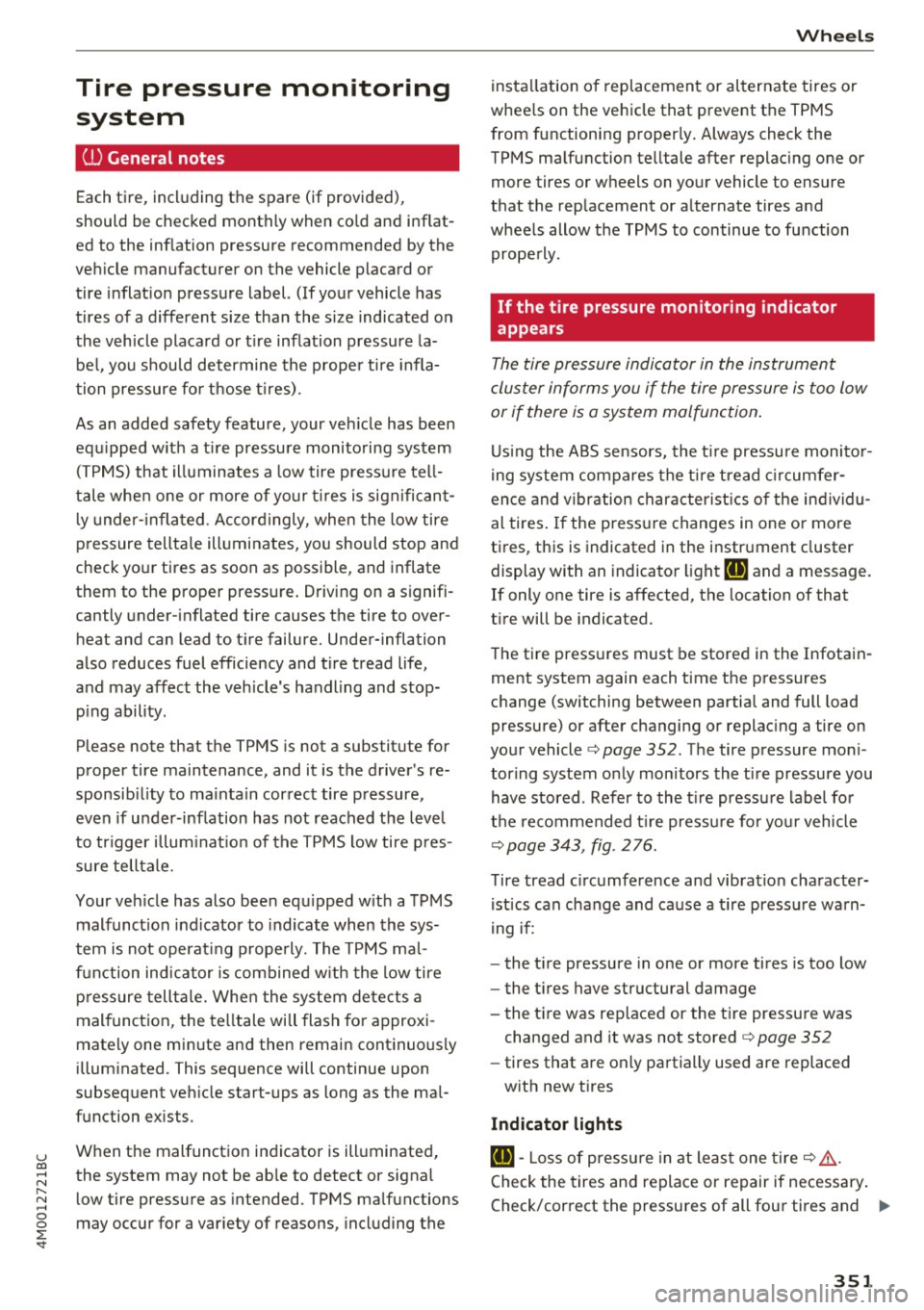
u co ...... N r-... N ...... 0
0
:E: '
UJ General notes
Each tire, including t he spare (if provided),
should be checked monthly when cold and inflat
e d to the inflation pressure recommended by the
veh icle manufacturer on the vehicle placard or
tire inflat ion pressure label. (If your vehicle has
tires of a different size than the size indicated on
the veh icle placard or t ire inflation pressure la
be l, you shou ld determine the prope r ti re infla
tion pressure fo r those t ires) .
As an added safety feature , your veh icle has been
equ ipped w ith a t ire pressure monitoring system
(TPMS) that illuminates a low tire p ress ure te ll
tale whe n one or more of yo ur t ires is significant
l y under- infla ted . Accordingly, when the low tire
p ressure tellta le ill uminates, yo u should stop and
check your tires as soon as possible, and inflate
them to the proper press ure. Driving on a s ignifi
cantly under-inflated tire causes the tire to over
heat and can lead to t ire failure. Under-inflation
also reduces fuel efficiency and tire tread life,
and may affect the veh icle's handling and stop
p ing ability.
P lease note that the TPMS is not a substitute for
proper tire maintenance, and it is the driver's re
sponsib ility to ma inta in correct tire p ressure,
even if u nder-inflation has not reached t he leve l
to tr igger illum inat io n of the TPMS low tire p res
sure telltale.
Your veh icle has also been equ ipped w ith a TPMS
malfunct ion ind icator to indicate when the sys
tem is not operat ing properly. The TPMS ma l
f u nction indicator is combined w ith the low tire
p ressure tellta le. Whe n the system de tects a
mal function, the te lltale will flash fo r approxi
mate ly one min ute and then remain continuo usly
illum inated. This sequence will continue upon
subseq uent veh icle start-ups as long as the ma l
function ex ists .
When the malfunction indicator is ill uminated,
the system may not be ab le to detect or signa l
low tire press ure as intended. TPMS ma lfunctions
may occur for a var iety of reasons, including the
Wh eel s
insta llation o f replacement or alternate tires or
whee ls on the vehicle that prevent the TPMS
from functioning p roper ly . Always check the
TPMS ma lfunction te lltale after replac ing one or
more tires or wheels on your vehicle to ensure
that the rep lacement or a lternate tires a nd
wheels allow the TPMS to continue to fu nction
prope rly .
If the tire pressure monitoring indicator
appears
The tire pressure indicator in the instrument
cluster informs you if the tire pressure is too low
or if there is a system mo/function .
Using the ABS se nsors, the t ire pressu re moni to r
i ng system compares the tire tread circumfer
en ce and vibr ation character ist ics of the ind ividu
al tires . If the press ure changes in one o r more
t ires , th is is indicated in the instrument cluster
display with an indicato r light
[I] and a message.
If only one tire is affected, the location of that
t ire will be indicated.
T he tire press ures must be stored in the Infotain
ment system again each time the p ressures
change (switching between partial and full load
pressure) or after changing or replac ing a tire on
your vehicle
c:> page 352. The tire pressure mon i
tor ing system on ly mon itors the tire pressure you
have stored . Refer to the t ire pressu re label fo r
the re commended t ire pressu re fo r yo ur vehicle
c:> page 343, fig . 2 76.
T ire tread c irc umference and vibra tion characte r
ist ics can change and ca use a tire press ure wa rn
i ng if :
- the t ire pressure in one or more tires is too low
- the t ires have structural damage
- the t ire was rep laced or the t ire pressu re was
changed and it was not stored
c:> page 352
- tires that a re on ly pa rtially used are replaced
w ith new tires
Indicator lights
[I]-L oss of pressu re in at leas t one tire c:> ,&. .
Check the tires and replace or repair if necessary .
Check/correct the pressures of all four tires and .,.
351
Page 354 of 402
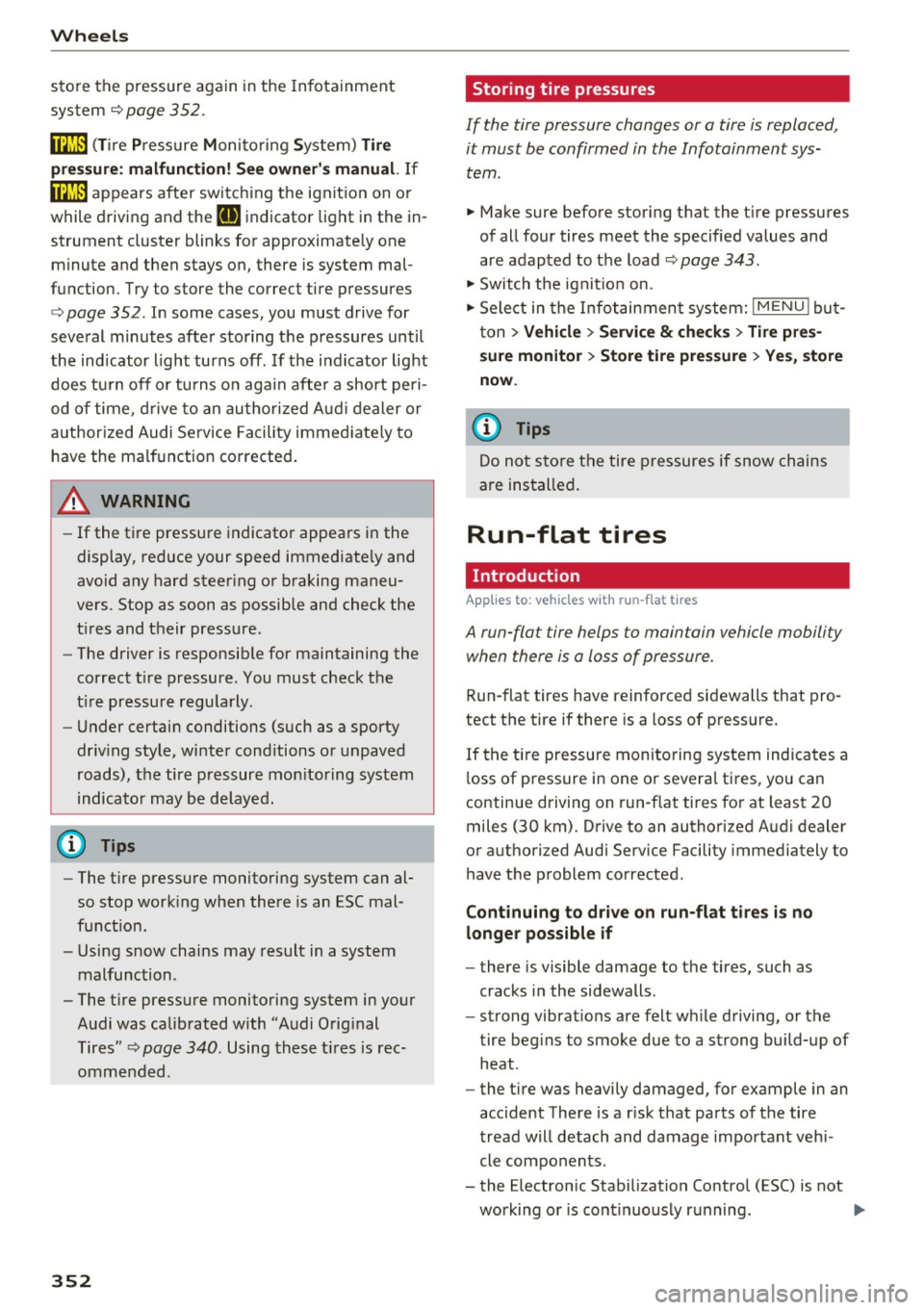
Wheels
store the pressure again in the Infotainment
system
¢ page 352.
mm (T ir e Pr essure Monito ring System) Tire
pressure : malfunction ! See owner' s manual.
If
mm appears after switch ing the ignit ion on o r
while driving and the
[I] indicator light in the in
strument cluster blinks fo r approximately one
minute and then stays on, there is system mal
function. Try to store the correct tire pressures
¢ page 352 . In some cases, you must drive for
several minutes after storing the pressures until
the ind icator light turns off . If the i ndicator light
does t urn off o r tu rns on aga in afte r a short peri
od of time , d rive to an au tho riz ed A ud i dealer o r
author ized Audi Service Facility immed iate ly to
have the ma lfunction co rrected .
A WARNING
-If the t ire pressu re indicator appears in the
display, reduce your speed immediate ly and
avoid any hard steer ing or braking maneu
vers. Stop as soon as possib le and check the
t ires and their pressu re.
- The driver is responsib le for maintaining the
correct tire pressure. You must check the
t ire pressure regu larly.
- Under certain conditions (such as a sporty
dr iv ing style, winter cond itions o r unpaved
roads), the tire p ressure mon itoring system
indicator may be delayed.
@ Tips
- The t ire pressure monitoring system can al
so stop work ing when there is an ESC mal
funct ion.
- Using snow chains may result in a system
malfunction.
- The t ire pressure monitoring system in your
Audi was calibrated with "A udi Orig inal
Tires"
¢ page 340. Using these ti res is rec
ommended .
352
' Storing tire pressures
If the tire pressure changes or a tire is replaced,
it must be confirmed in the Infotainment sys
tem .
"Make sure before stor ing that the t ire pressures
of all four tires meet the specified values and
are adapted to the load
¢ page 343 .
"Switch the ignit io n on.
" Sele ct in the Infotainment system:
IMENU J but
ton
> V ehicle > Servi ce & checks > Tire pres
s u re monitor
> Store tire pre ssure > Ye s, store
now .
'
(D Tips
Do not store the tire pressures if snow chains
are installed .
Run-flat tires
Introduction
Applies to: vehicles with run-flat tires
A run-flat tire helps to maintain vehicle mobility
when there is a loss of pressure.
Run-flat tires have reinforced sidewalls that pro
tect the tire if there is a loss of pressure.
If the ti re pressure monitoring system indicates a
l oss of pressure in one or severa l ti res, you can
continue driving on run-flat tires fo r at least 20
miles (30 km). Drive to an authorized A udi dealer
or authorized Audi Serv ice Facility immediately to
have the problem corrected.
Continuing to d rive on run-flat tire s is no
longe r po ssible if
- there is visible damage to the tires, such as
cracks in the sidewalls .
- strong vibrat ions are felt wh ile driving, or the
tire beg ins to smoke due to a strong build-up of
heat .
- the t ire was heavily damaged, for example in an
accident There is a r isk that parts of the tire
tread will detach and damage important veh i
cle components .
- the Electron ic Stabilization Contro l (ESC) is not
working or is cont inuously running .
Page 401 of 402
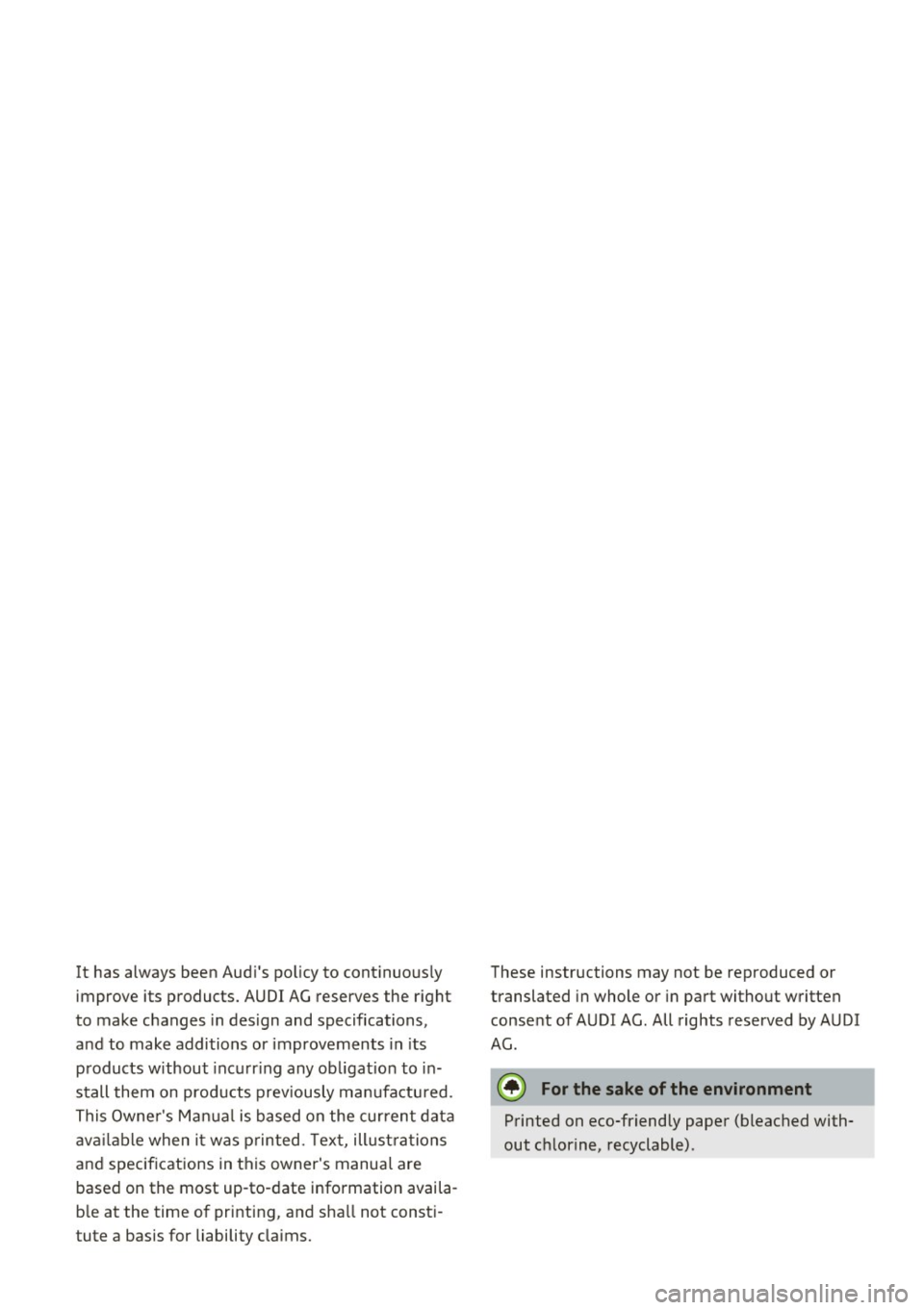
It has always been Audi's po licy to cont inuous ly
improve its products. AUDI AG reserves the r ight
to make changes in design and specifications ,
and to make additions or improvements in its
products without incu rr ing any ob ligat io n to i n
stall them on products prev iously manufactured .
This Owne r's Ma nual is based on the current data
a va ilable when it was printed. Text, ill ust rations
and specif ications in this owner's manua l are
based on the most up-to-date information availa
b le at the time of printing, and sha ll not const i
tute a basis for liability claims. These instructions may not be reproduced or
translated
in whole or in part without written
conse nt of AUDI AG. All rights reserved by AUDI
AG.
@) For the sake of the environment
Printed on eco-friendly paper (bleached with
out chlorine, recyclable) .